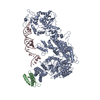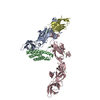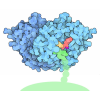[English] 日本語
 Yorodumi
Yorodumi- SASDBR2: Contactin-associated protein-like 2 (Caspr2) extracellular domain... -
+ Open data
Open data
- Basic information
Basic information
| Entry | Database: SASBDB / ID: SASDBR2 |
|---|---|
 Sample Sample | Contactin-associated protein-like 2 (Caspr2) extracellular domains 1-1261.
|
| Function / homology |  Function and homology information Function and homology informationlimbic system development / neuron recognition / clustering of voltage-gated potassium channels / protein localization to juxtaparanode region of axon / vocal learning / superior temporal gyrus development / paranodal junction / vocalization behavior / paranode region of axon / striatum development ...limbic system development / neuron recognition / clustering of voltage-gated potassium channels / protein localization to juxtaparanode region of axon / vocal learning / superior temporal gyrus development / paranodal junction / vocalization behavior / paranode region of axon / striatum development / thalamus development / juxtaparanode region of axon / adult behavior / transmission of nerve impulse / positive regulation of gap junction assembly / social behavior / axolemma / prepulse inhibition / neuron projection morphogenesis / voltage-gated potassium channel complex / learning / brain development / cerebral cortex development / GABA-ergic synapse / neuron projection development / presynaptic membrane / protease binding / perikaryon / transmembrane transporter binding / early endosome / cell population proliferation / cell adhesion / axon / neuronal cell body / dendrite / glutamatergic synapse / enzyme binding / cell surface / Golgi apparatus / membrane Similarity search - Function |
| Biological species |  Homo sapiens (human) Homo sapiens (human) |
 Citation Citation |  Journal: J Biol Chem / Year: 2016 Journal: J Biol Chem / Year: 2016Title: Structural Characterization of the Extracellular Domain of CASPR2 and Insights into Its Association with the Novel Ligand Contactin1. Authors: Eva N Rubio-Marrero / Gabriele Vincelli / Cy M Jeffries / Tanvir R Shaikh / Irene S Pakos / Fanomezana M Ranaivoson / Sventja von Daake / Borries Demeler / Antonella De Jaco / Guy Perkins / ...Authors: Eva N Rubio-Marrero / Gabriele Vincelli / Cy M Jeffries / Tanvir R Shaikh / Irene S Pakos / Fanomezana M Ranaivoson / Sventja von Daake / Borries Demeler / Antonella De Jaco / Guy Perkins / Mark H Ellisman / Jill Trewhella / Davide Comoletti /     Abstract: Contactin-associated protein-like 2 (CNTNAP2) encodes for CASPR2, a multidomain single transmembrane protein belonging to the neurexin superfamily that has been implicated in a broad range of human ...Contactin-associated protein-like 2 (CNTNAP2) encodes for CASPR2, a multidomain single transmembrane protein belonging to the neurexin superfamily that has been implicated in a broad range of human phenotypes including autism and language impairment. Using a combination of biophysical techniques, including small angle x-ray scattering, single particle electron microscopy, analytical ultracentrifugation, and bio-layer interferometry, we present novel structural and functional data that relate the architecture of the extracellular domain of CASPR2 to a previously unknown ligand, Contactin1 (CNTN1). Structurally, CASPR2 is highly glycosylated and has an overall compact architecture. Functionally, we show that CASPR2 associates with micromolar affinity with CNTN1 but, under the same conditions, it does not interact with any of the other members of the contactin family. Moreover, by using dissociated hippocampal neurons we show that microbeads loaded with CASPR2, but not with a deletion mutant, co-localize with transfected CNTN1, suggesting that CNTN1 is an endogenous ligand for CASPR2. These data provide novel insights into the structure and function of CASPR2, suggesting a complex role of CASPR2 in the nervous system. |
 Contact author Contact author |
|
- Structure visualization
Structure visualization
| Structure viewer | Molecule:  Molmil Molmil Jmol/JSmol Jmol/JSmol |
|---|
- Downloads & links
Downloads & links
-Data source
| SASBDB page |  SASDBR2 SASDBR2 |
|---|
-Related structure data
| Similar structure data |
|---|
- External links
External links
| Related items in Molecule of the Month |
|---|
-Models
| Model #413 |  Type: dummy / Software: DAMMIN / Radius of dummy atoms: 3.70 A / Chi-square value: 0.594441 / P-value: 0.080000  Search similar-shape structures of this assembly by Omokage search (details) Search similar-shape structures of this assembly by Omokage search (details) |
|---|---|
| Model #414 |  Type: atomic / Software: CRYSOL / Radius of dummy atoms: 1.90 A / Chi-square value: 0.867 / P-value: 0.030000  Search similar-shape structures of this assembly by Omokage search (details) Search similar-shape structures of this assembly by Omokage search (details) |
| Model #415 |  Type: atomic / Software: CORAL / Radius of dummy atoms: 1.90 A / Chi-square value: 0.7056 / P-value: 0.008000  Search similar-shape structures of this assembly by Omokage search (details) Search similar-shape structures of this assembly by Omokage search (details) |
- Sample
Sample
 Sample Sample | Name: Contactin-associated protein-like 2 (Caspr2) extracellular domains 1-1261. Specimen concentration: 1.00-9.57 |
|---|---|
| Buffer | Name: HEPES / Concentration: 10.00 mM / pH: 7.4 / Composition: 150 mM NaCl |
| Entity #272 | Name: Caspr2 / Type: protein Description: Contactin-associated protein-like 2 extracellular domains (1-1261) Formula weight: 140.4 / Num. of mol.: 1 / Source: Homo sapiens / References: UniProt: Q9UHC6 Sequence: MQAAPRAGCG AALLLWIVSS CLCRAWTAPS TSQKCDEPLV SGLPHVAFSS SSSISGSYSP GYAKINKRGG AGGWSPSDSD HYQWLQVDFG NRKQISAIAT QGRYSSSDWV TQYRMLYSDT GRNWKPYHQD GNIWAFPGNI NSDGVVRHEL QHPIIARYVR IVPLDWNGEG ...Sequence: MQAAPRAGCG AALLLWIVSS CLCRAWTAPS TSQKCDEPLV SGLPHVAFSS SSSISGSYSP GYAKINKRGG AGGWSPSDSD HYQWLQVDFG NRKQISAIAT QGRYSSSDWV TQYRMLYSDT GRNWKPYHQD GNIWAFPGNI NSDGVVRHEL QHPIIARYVR IVPLDWNGEG RIGLRIEVYG CSYWADVINF DGHVVLPYRF RNKKMKTLKD VIALNFKTSE SEGVILHGEG QQGDYITLEL KKAKLVLSLN LGSNQLGPIY GHTSVMTGSL LDDHHWHSVV IERQGRSINL TLDRSMQHFR TNGEFDYLDL DYEITFGGIP FSGKPSSSSR KNFKGCMESI NYNGVNITDL ARRKKLEPSN VGNLSFSCVE PYTVPVFFNA TSYLEVPGRL NQDLFSVSFQ FRTWNPNGLL VFSHFADNLG NVEIDLTESK VGVHINITQT KMSQIDISSG SGLNDGQWHE VRFLAKENFA ILTIDGDEAS AVRTNSPLQV KTGEKYFFGG FLNQMNNSSH SVLQPSFQGC MQLIQVDDQL VNLYEVAQRK PGSFANVSID MCAIIDRCVP NHCEHGGKCS QTWDSFKCTC DETGYSGATC HNSIYEPSCE AYKHLGQTSN YYWIDPDGSG PLGPLKVYCN MTEDKVWTIV SHDLQMQTPV VGYNPEKYSV TQLVYSASMD QISAITDSAE YCEQYVSYFC KMSRLLNTPD GSPYTWWVGK ANEKHYYWGG SGPGIQKCAC GIERNCTDPK YYCNCDADYK QWRKDAGFLS YKDHLPVSQV VVGDTDRQGS EAKLSVGPLR CQGDRNYWNA ASFPNPSSYL HFSTFQGETS ADISFYFKTL TPWGVFLENM GKEDFIKLEL KSATEVSFSF DVGNGPVEIV VRSPTPLNDD QWHRVTAERN VKQASLQVDR LPQQIRKAPT EGHTRLELYS QLFVGGAGGQ QGFLGCIRSL RMNGVTLDLE ERAKVTSGFI SGCSGHCTSY GTNCENGGKC LERYHGYSCD CSNTAYDGTF CNKDVGAFFE EGMWLRYNFQ APATNARDSS SRVDNAPDQQ NSHPDLAQEE IRFSFSTTKA PCILLYISSF TTDFLAVLVK PTGSLQIRYN LGGTREPYNI DVDHRNMANG QPHSVNITRH EKTIFLKLDH YPSVSYHLPS SSDTLFNSPK SLFLGKVIET GKIDQEIHKY NTPGFTGCLS RVQFNQIAPL KAALRQTNAS AHVHIQGELV ESNCGASPLT LSPMSSATDP WHLDHLDSAS ADFPYNPGQG QAIRNGVNRN S |
-Experimental information
| Beam | Instrument name: Anton Paar SAXSess / City: Salt Lake City, University of Utah / 国: USA  / Shape: Line collimation / Type of source: X-ray in house / Wavelength: 0.1542 Å / Dist. spec. to detc.: 264.5 mm / Shape: Line collimation / Type of source: X-ray in house / Wavelength: 0.1542 Å / Dist. spec. to detc.: 264.5 mm | |||||||||||||||||||||||||||||||||
|---|---|---|---|---|---|---|---|---|---|---|---|---|---|---|---|---|---|---|---|---|---|---|---|---|---|---|---|---|---|---|---|---|---|---|
| Detector | Name: 2D position-sensitive image plates / Pixsize x: 42.3 mm | |||||||||||||||||||||||||||||||||
| Scan |
| |||||||||||||||||||||||||||||||||
| Distance distribution function P(R) |
| |||||||||||||||||||||||||||||||||
| Result |
|
 Movie
Movie Controller
Controller

















